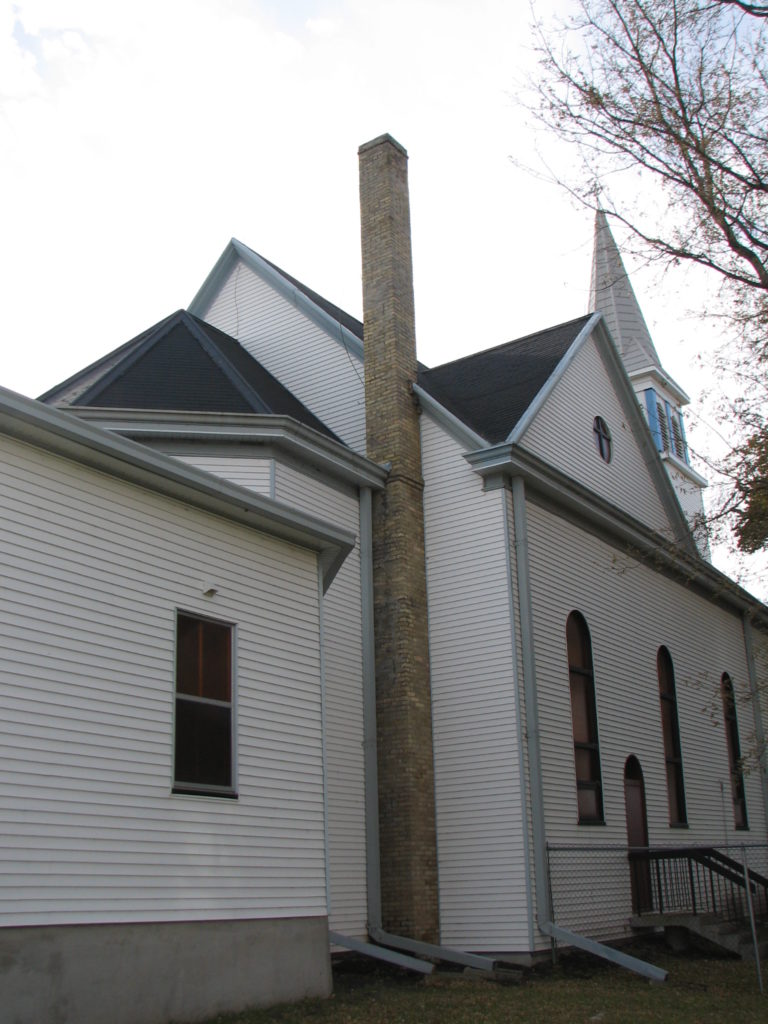ST ADOLPHE 2021 NEST SITE SUMMARY & THE ALL-ON ACTIVITY OF THE MCSI “OFF” SEASON
Monday was a beautiful morning at the St Adolphe Church Tower site. Warm, gentle winds blew and just a few clouds punctuated the sunny sky. The blooming flowers in the planters were showing well. So, I ripped them all out. What’s wrong with this picture? Well, it was Monday October 18th. The predicted daily high of ~22 C was near to setting yet another heat record.
But Mother Nature is due to get back on track. The first frosts will descend Wednesday as temperatures yield to more seasonal values. It really was time to put the garden planters to rest for the winter.
Now the 2021 Chimney Swift season in St Adolphe has been put to rest too. Check out the yearly nest site summary at: https://www.mbchimneyswift.com/Documents/stadolphe_2021.pdf This year played out in similar fashion to recent summer scenarios – feeding was challenged and soon after a successful fledging, unsuccessful breeders started to leave St Adolphe. Breeding swifts at two nest sites were successful in their attempts to raise and fledge young. The Main St pair fledged 5 juveniles which was 100% of their eggs laid; this was based on behaviour observations and observations of the physical evidence in the cleanout trap. The breeding pair at the Church was assisted all season long by a helper. Two fledglings launched from that nest site; as no cleanout trap is accessible, breeding outcomes are based entirely on behaviour observations.

Back to the all-important helper at the Church…while helpers are often associated with nest sites, the confirmatory data collected this year was especially enlightening. Sometimes you have to break away from standard monitoring protocols and observe with “adaptive sampling” – increasing the length and frequency of sessions – to verify or discount your notions of the mysteries that may be playing out inside the chimney.
If you’ve wondered about how to track a helper at a nest site, or had the challenge of doing so already and want to compare experiences, here’s my “Diary of a Helper” …
The breeding pair at the Church started nest building on May 31. Incubation likely started ~June 17 (>50%attendance) and a classic incubation exchange was seen June 26. The predicted hatching date range was July 4-7 and actual hatching occurred July 5 (increase to 2 X hour entry/exit cycles). The predicted date range for transitioning from feeding brooded to non-brooded juveniles, at Day 6-7, was July 10-11.
On July 9, Day 5, a helper was on site as determined by a unique entry style. The helper at the Church made an unusually awkward entry – the bird approached low, from the notch between the eastern roof and chimney, fluttered repeatedly, “bunny hopped” over to the rim then dropped in. The breeding adult swifts at the Church typically had direct, fast entries – one swift usually has dropped or dove from height, the other swift usually has approached low to the rim, flared the wings up, then dropped quickly into the chimney. Of interest: the Brodeur Bros./Daycare nesting attempt failed on July 7.
On July 10, Day 6, a helper was onsite based on a unique entry style: a swift made ~3 loops around the chimney, with decreasing diameter, then flared its wings and relocated to the side, low to the rim, before dropping in. Behaviour observations indicated the juveniles were non-brooded: 5-8 swifts made repeated flyovers with movements characterized as: 1.) dive ‘n’ veer off; 2.) drop ‘n’ veer off; 3.) flyover with head movement over the rim; or 4.) drop, stall, peer ‘n’ veer off. The Kyle’s note that when non-brooded juveniles are exposed in the nest, other swifts in the area visit to see the new members of their community.
On July 14, another indication of a helper was seen by the pattern (sequence) and interval between entry/exits made at the Church. For the session starting at 10:38 AM:
- 10:53:10 Entry
- 10:53:53 Exit
- 10:53:54 Exit – one swift was in the chimney at the start of observations; possibly breeding pair moving together.
- 11:06:51 Entry – low approach then up to notch of roof/rim before entry; ~13 minute between-visit interval also suggests this bird was not one of previous two exiting swifts – it is a short time to feed and return as no swifts were seen feeding nearby.
Another indication of a helper onsite = greater feeding rates (frequency of entry events) at the Church compared to Main St site where 2 adults are feeding young of similar age. For example, Saturday July 17th, the feeding rate = 8 x hour at the Church vs. a feeding rate = 4 X hour at Main St.
On July 21, Day 17, an electrical storm descended on St Adolphe. From the safety of the parked truck, observations were made for 90 minutes; 2 entries were made from height and 2 entries were made lower to the chimney rim. A maximum of 2 swifts took refuge during the storm; 1 swift entered 45 minutes after light to heavy rain fell. As the storm ended “as the robins sang”, 2 swifts left together. So, there was no indication of the helper being present – either by unique entry style or head count.
On July 23, Day 19, 3 distinct entry styles were seen for swifts entering the Church in the morning; the feeding rate was ~6 X hour as compared to ~3X hour at Main St. The stage was set for a long evening monitoring session at the Church…
Sunset on July 23 was 9:25 PM. Daytime observations ran from 8:05-8:55 PM (50 minutes), then the roosting hour observations began and ran until 9:55 PM (60 minutes). Many times, during the daytime portion, 10 swifts were seen flying in formation around the Church – a great deal of social interaction took place! Frenzied, repeat flyovers of the rim and dropping ‘n’ veering off “snoop” behaviour was seen. Entry/exit styles and directions were affected by the melee. Feeding rates were 2 X hour as the adults were spending time interacting with each other.
Group sizes peaked at 8 swifts during the early part of the roosting hour, then decreased. Two consecutive entries to the Church were made by 9:25 PM. With ~ 15 minutes to curfew, a swift made a fast approach, veered away from the rim and circled back from the cemetery to enter quickly. With 3 consecutive entries, a helper was confirmed to be onsite! However, a quick exit was made and no further entries were made before the roosting hour observations were finished. Two roosting swifts spent the night at the Church.
SAT. JULY 31: Today is The Day, although it is a slightly early Day 27 fledging date, but no complaints here! Two fledglings (at least) were airborne from the St Adolphe Church chimney when I checked this morning. Will get eyes on it again earlier tomorrow morning to see if any other fledglings are up and out and about.
Usually, it is Day 28-30 when they fledge but there can be wobble in the dates. For example, if I saw no evidence of hatching one morning, and the eggs all hatched as I turned my back, that would introduce a one-day error if the next morning was designated hatching day. You know how these birds are. And sometimes, the young ones just get out flying earlier than others.
The two sleek, black fledglings seen today were very good fliers. The first glimpse I had of them was in a group of 5 but one adult, and what turned out to be the fledglings, were closer together – not trio flying but definitely grouped together, low ‘n’ slow. After some time without seeing swifts, the fledglings made entries one after the other without hesitation having arrived at the rim from low over my head. There was that perfect celestial orientation of good luck to i.d. the young ones!
MON. AUGUST 2: During a morning session, the 2 Church fledglings came in side by side for an entry; an adult entered shortly afterward. Then after crazy counting, I got 11 in the air during a local melee. So, 14 swifts were accounted for – again likely (2 adults X 6 nest sites) + 2 fledglings.
In the evening, Rob and I watched the Church for 1/2 hour then followed through with the roosting hour. Four consecutive entries were made – 2 of them were slower and flutterier. Then one fast entry and exit shortly afterward took place. We interpret this to be 2 adults + 2 fledglings roosting for the night with a quick checkup and departure by the helper. 10 days ago, 2 adults roosted and a similar entry-quick exit was made – we thought the helper made a quick pit stop and went to roost with its partner in whatever nest site they occupy (SE or NE Club or Brodeur Bros/Daycare or 2019-31).

As we drift into the late fall, then winter season, a whole lot of “helper” work will be done behind the scenes by the MCSI Steering Committee. Amanda will load the 2021 database with all of your wonderful monitoring data; Frank will update and refresh the website; manuscripts will be drafted and reviewed by many of us (yup, time to dig into the data archives); and special projects such as Rob’s Lower Fort Garry chimney inventory, and Tim ‘n’ Nicole’s installation of purpose-built towers at Selkirk Mental Health Centre, will continue. We are always looking for candidate chimneys to repair with our Habitat Stewardship Program funds. Unlike the Chimney Swifts, we don’t migrate, so be in touch if you have thoughts to share.
All the best for your dreaming-of-swifts season and we hope to see you by the chimney sides in 2022!
Barb Stewart for the MCSI Steering Committee team: Christian Artuso, Ron Bazin, Neil Butchard, Lewis Cocks, Ken DeSmet, Jack Dubois, Nicole Firlotte, Frank Machovec, Tim Poole, Amanda Shave, and Rob Stewart.
